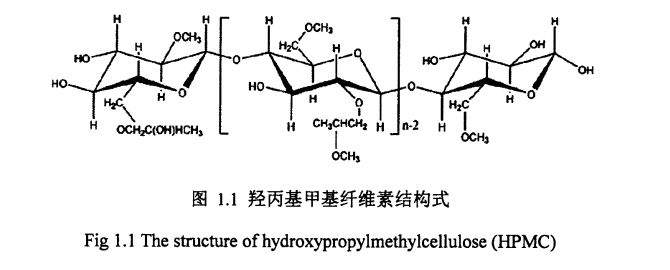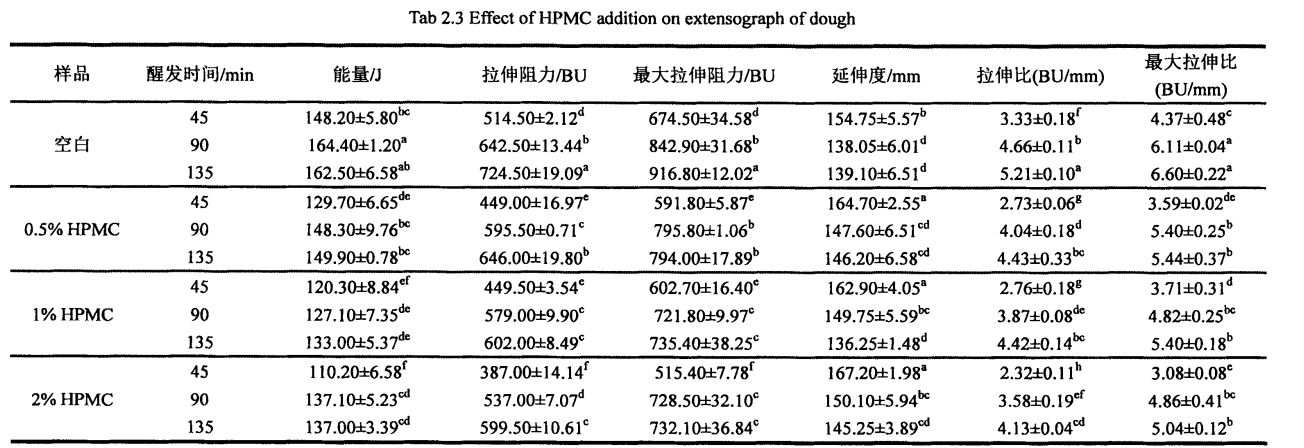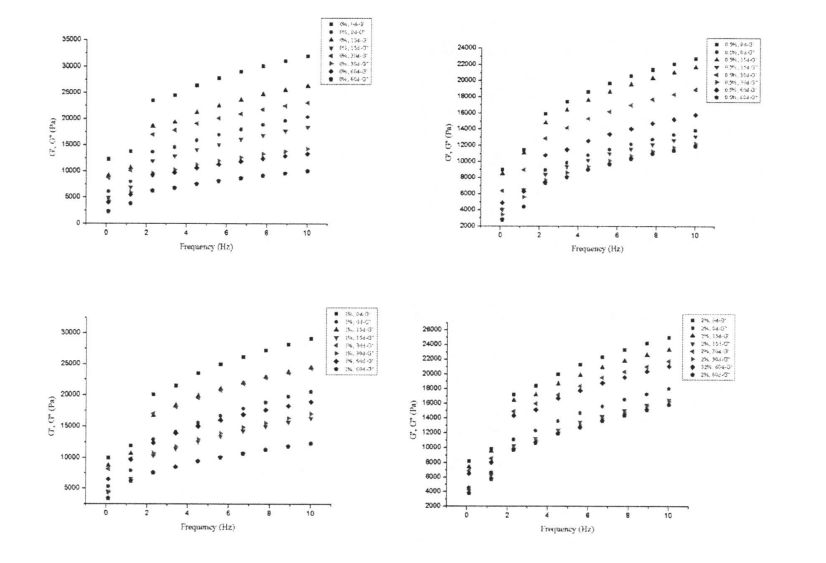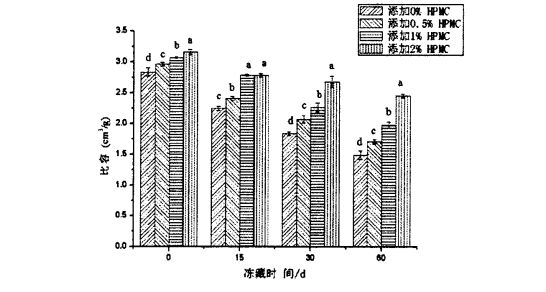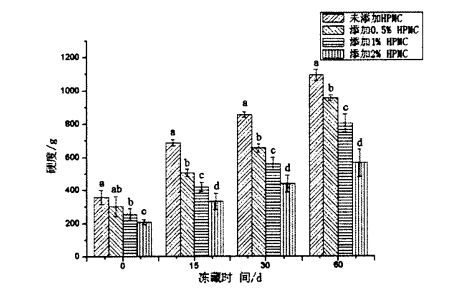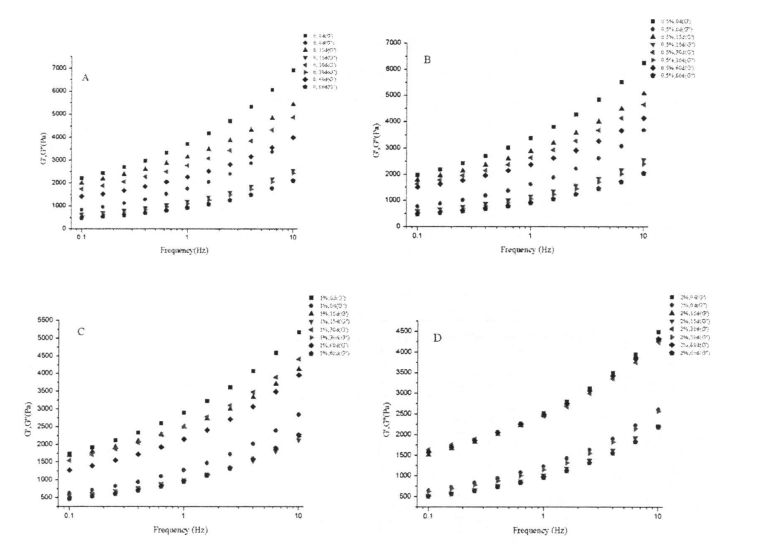Forbedring av prosesseringsegenskapene til frossen deig har viss praktisk betydning for å realisere storstilt produksjon av praktisk damp av høy kvalitet. In this study, a new type of hydrophilic colloid (hydroxypropyl methylcellulose, Yang, MC) was applied to frozen dough. Effektene av 0,5%, 1%, 2%) på behandlingsegenskapene til frossen deig og kvaliteten på dampet brød ble evaluert for å evaluere forbedringseffekten av HPMC. Influence on the structure and properties of components (wheat gluten, wheat starch and yeast).
De eksperimentelle resultatene av farinalitet og tøyning viste at tilsetningen av HPMC forbedret prosessenes prosesseringsegenskaper, og de dynamiske frekvensskanningsresultatene viste at viskoelastisiteten til deigen tilsatt med HPMC i frysepunktet endret seg lite, og deignettverksstrukturen forble relativt stabil. In addition, compared with the control group, the specific volume and elasticity of the steamed bread were improved, and the hardness was reduced after the frozen dough added with 2% HPMC was frozen for 60 days.
Starch is the most abundant dry matter in dough, and changes in its structure will directly affect the gelatinization characteristics and the quality of the final product. X. Resultatene av røntgendiffraksjon og DSC viste at den relative krystalliniteten til stivelse økte og gelatiniseringsentalpien økte etter frossen lagring. With the prolongation of frozen storage time, the swelling power of starch without HPMC addition decreased gradually, while the starch gelatinization characteristics (peak viscosity, minimum viscosity, final viscosity, decay value and retrogradation value) all increased significantly; During the storage time, compared with the control group, with the increase of HPMC addition, the changes of starch crystal structure and gelatinization properties gradually decreased.
Key words: steamed bread; frozen dough; hydroxypropyl methylcellulose; wheat gluten; wheat starch; gjær.
Innholdsfortegnelse
1.1.5 Research status of frozen dough……………………………………. ............................................. 4
1.1.7 Hydroksypropylmetylcellulose (hydroksypropylmetylcellulose, I-IPMC) ………. 5
112 Formål og betydning av studien ...................................................................................................
2.3 Eksperimentelle resultater og diskusjon ………………………………………………………………………. 11
2.3.1 Indeks for grunnleggende komponenter av hvetemel ………………………………………………………… .1L
2.3.3 Effekten av HPMC -tilsetning på strekkegenskapene til deigen ………………………… 12
2.4 Kapitteloppsummering .......................................................................................................................
3.2.4 Eksperimentelle metoder ........................................................................................................... 25
3.3.2 The effect of adding amount of HPMC and freezing storage time on the freezable moisture content (CFW) and thermal stability……………………………………………………………………. 30
3.3.3 Effects of HPMC addition amount and freezing storage time on free sulfhydryl content (C vessel) …………………………………………………………………………………………………………. . 34
Chapter 4 Effects of HPMC addition on starch structure and properties under frozen storage conditions………………………………………………………………………………………………………………………… 44
4.1 Introduction .............................................................................................................................. . 44
4.2 Experimental materials and methods ................................................................................. 45
4.2.1 Eksperimentelle materialer ................................................................................................ ………… .45
4.3 Analyse og diskusjon ................................................................................................................... 48
4.3.1 Innhold av grunnleggende komponenter av hvetestivelse ……………………………………………………. 48
4.3.3 Effects of HPMC addition and freezing storage time on the shear viscosity of starch paste………………………………………………………………………………………………………………………………………. 52
4.3.6 Effekter av I-IPMC tilsetningsmengde og frossen lagringstid på de termodynamiske egenskapene til stivelse …………………………………………………………………………………………………………. . 57
4.4 Kapitteloppsummering ................................................................................................................... 6 1
Chapter 5 Effects of HPMC addition on yeast survival rate and fermentation activity under frozen storage conditions………………………………………………………………………………………………. . 62
5.1Introduction .................................................................................................................................... 62
5.2 Materials and methods ............................................................................................................ 62
5.2.2 Experimental methods . . . . . …………………………………………………………………………. 63
5.3 Results and Discussion ............................................................................................................... 64
5.3.3 The effect of adding amount of HPMC and freezing time on the content of glutathione in dough……………………………………………………………………………………………………………66. ""
5.4 Chapter Summary ........................................................................................................................ 67
6.1 Conclusion ................................................................................................................................. . 68
6.2 Outlook ................................................................................................................................... 68
Figur 1.1 Den strukturelle formelen for hydroksypropylmetylcellulose ………………………. . 6
Figur 2.4 Effekten av HPMC -tilsetning og frysetid på elastisiteten til dampet brød ………………………………………………………………………………………………………………………………. . 20
Figure 3.1 The effect of HPMC addition and freezing time on the rheological properties of wet gluten…………………………………………………………………………………………………………………………. 30
Figure 3.2 Effects of HPMC addition and freezing time on the thermodynamic properties of wheat gluten………………………………………………………………………………………………………………. . 34
Figure 3.3 Effects of HPMC addition and freezing time on free sulfhydryl content of wheat gluten……………………………………………………………………………………………………………………………... . 35
Figur 3.7 Effekten av HPMC -tilsetning og frysetid på den mikroskopiske glutenettverksstrukturen ………………………………………………………………………………………………………… .... 43
Figure 4.1 Starch gelatinization characteristic curve ............................................................... 51
Figure 4.2 Fluid thixotropy of starch paste ................................................................................. 52
Figure 4.3 Effects of adding amount of MC and freezing time on the viscoelasticity of starch paste……………………………………………………………………………………………………………………... . 57
Figure 4.5 Effects of HPMC addition and freezing storage time on the thermodynamic properties of starch…………………………………………………………………………………………………………. . 59
Figure 5.2 The effect of HPMC addition and freezing time on the yeast survival rate…………………………………………………………………………………………………………………………………... . 67
Figure 5.3 Microscopic observation of yeast (microscopic examination) …………………………………………………………………………………………………………………………. 68
Figur 5.4 Effekten av HPMC -tilsetning og frysetid på glutathione (GSH) innhold ………………………………………………………………………………………………………………………………… ... 68
Table 2.1 The basic ingredient content of wheat flour…………………………………………………. 11
Table 3.2 Effects of I-IPMC addition amount and freezing storage time on the phase transition enthalpy (Yi IV) and freezer water content (e chat) of wet gluten………………………. 31
Table 3.3 Effects of HPMC addition amount and freezing storage time on the peak temperature (product) of thermal denaturation of wheat gluten…………………………………………. 33
Table 3.6 Effects of I-IPMC addition and freezing storage time on the surface hydrophobicity of wheat gluten……………………………………………………………………………………………. 41
Tabell 4.3 Effekter av I-IPMC tilsetning og frysetid på skjærviskositeten til hvetestivelse pasta ……………………………………………………………………………………………………………………………. 55
3)Research on dough preparation and steamed bread making technology. Research on the influence of steamed bread production process conditions on its quality and process optimization; Liu Changhong et al. (2009) showed that in the process of dough conditioning, process parameters such as water addition, dough mixing time, and dough pH value have an impact on the whiteness value of steamed bread. It has a significant impact on sensory evaluation. Hvis prosessforholdene ikke er egnet, vil det føre til at produktet blir blått, mørkt eller gult. Forskningsresultatene viser at under deigforberedelsesprosessen når mengden vann tilsatt 45%, og deigblandingstiden er 5 minutter, ~ Når pH -verdien til deigen var 6,5 i 10 minutter, var hvithetsverdien og sensorisk evaluering av de dampede bollene målt med hvithetsmåleren den beste. When rolling the dough 15-20 times at the same time, the dough is flaky, smooth, elastic and shiny surface; when the rolling ratio is 3:1, the dough sheet is shiny, and the whiteness of the steamed bread increases [l to; Li, et a1. (2015) explored the production process of compound fermented dough and its application in steamed bread processing [13].
4)Research on quality improvement of steamed bread. Forskning på tillegg og anvendelse av dampede brødkvalitetsutviklere; Hovedsakelig inkludert tilsetningsstoffer (som enzymer, emulgatorer, antioksidanter, etc.) og andre eksogene proteiner [14], stivelse og modifisert stivelse [15], etc. Tilsetningen og optimaliseringen av den tilsvarende prosessen er spesielt bemerkelsesverdige at de siste årene har vært en annen tilknytning og andre tilknytede glutten. requirements of celiac disease (Dietary needs of patients with Coeliac Disease [16.1 cit.
De fleste studier har funnet at dannelse og vekst av iskrystaller i frosne matvarer er en viktig faktor som fører til forverring av produktkvaliteten [291]. Iskrystaller reduserer ikke bare overlevelseshastigheten til gjær, men svekker også glutenstyrken, påvirker stivelseskrystalliniteten og gelstrukturen, og skader gjærcellene og frigjør den reduserende glutathione, noe som reduserer glutenkapasiteten til gluten. In addition, in the case of frozen storage, temperature fluctuations can cause ice crystals to grow due to recrystallization [30]. Therefore, how to control the adverse effects of ice crystal formation and growth on starch, gluten and yeast is the key to solving the above problems, and it is also a hot research field and direction. In the past ten years, many researchers have been engaged in this work and achieved some fruitful research results. However, there are still some gaps and some unresolved and controversial issues in this field, which need to be further explored, such as:
a) Hvordan beherske kvalitetsforringelsen av frossen deig med forlengelsen av frossen lagringstid, spesielt hvordan man kan kontrollere påvirkningen av dannelsen og veksten av iskrystaller på strukturen og egenskapene til de tre hovedkomponentene til deigen (stivelse, gluten og gjær), er fremdeles et problem. Hotspots and fundamental issues in this research field;
I.Studie endringene i strukturen og egenskapene til frossen deig med utvidelse av frysing av lagringstid, for å utforske årsakene til forverring av produktkvalitet, spesielt effekten av iskrystallisering på biologiske makromolekyler (protein, stivelse, etc.), for eksempel iskrystallisering. Formation and growth and its relationship with water state and distribution; changes in wheat gluten protein structure, conformation and properties [31]; changes in starch structure and properties; changes in dough microstructure and related properties, etc. 361.
Studies have shown that the main reasons for the deterioration of the processing properties of frozen dough include: 1) During the freezing process, the survival of yeast and its fermentation activity are significantly reduced; 2) The continuous and complete network structure of the dough is destroyed, resulting in the air holding capacity of the dough. og strukturstyrken er kraftig redusert.
Ii. Optimalisering av frossen deigproduksjonsprosess, frosne lagringsforhold og formel. During the production of frozen dough, temperature control, proofing conditions, pre-freezing treatment, freezing rate, freezing conditions, moisture content, gluten protein content, and thawing methods will all affect the processing properties of frozen dough [37]. In general, higher freezing rates produce ice crystals that are smaller in size and more uniformly distributed, while lower freezing rates produce larger ice crystals that are not uniformly distributed. In addition, a lower freezing temperature even below the glass transition temperature (CTA) can effectively maintain its quality, but the cost is higher, and the actual production and cold chain transportation temperatures are usually small. In addition, the fluctuation of the freezing temperature will cause recrystallization, which will affect the quality of the dough.
Iii. Using additives to improve the product quality of frozen dough. In order to improve the product quality of frozen dough, many researchers have made explorations from different perspectives, for example, improving the low temperature tolerance of material components in frozen dough, using additives to maintain the stability of the dough network structure [45.56], etc. Among them, the use of additives is an effective and widely used method. Mainly include, i) enzyme preparations, such as, transglutaminase, O [. Amylase; ii) emulsifiers, such as monoglyceride stearate, DATEM, SSL, CSL, DATEM, etc.; iii) antioxidants, ascorbic acid, etc.; iv) polysaccharide hydrocolloids, such as guar gum, yellow Originalgum, gum Arabic, konjac gum, sodium alginate, etc.; v) other functional substances, such as Xu, et a1. (2009) tilførte isstruktureringsproteiner til våt glutenmasse under frysepunktforhold, og studerte dens beskyttende effekt og mekanisme på strukturen og funksjonen til glutenprotein [Y71.
Ⅳ. Breeding of antifreeze yeast and application of new yeast antifreeze [58-59]. Sasano, et a1. (2013) oppnådde frysetolerante gjærstammer gjennom hybridisering og rekombinasjon mellom forskjellige stammer [60-61], og S11I, Yu, & Lee (2013) studerte et biogen is-nukleating middel avledet av Erwinia-herbikaner som ble brukt til å beskytte fermenteringen av gjæren.
1.1.7hydroksypropylmetylcellulose (hydroksypropylmetylcellulose, I-IPMC)
Although HPMC has been used in pasta to a certain extent, it is mainly used as an anti-aging agent and water-retaining agent for bread, etc., which can improve product specific volume, texture properties and prolong shelf life [71.74]. Sammenlignet med hydrofile kolloider som guargummi, xantangummi og natriumalginat [75-771], er det imidlertid ikke mange studier på anvendelsen av HPMC i frossen deig, enten det kan forbedre kvaliteten på dampet brød behandlet fra frossen deig. There is still a lack of relevant reports on its effect.
It is precisely because the relevant application research of HPMC in Chinese noodles is still relatively lacking. Derfor er formålet med dette eksperimentet å utvide anvendelsen av HPMC til frossen deig, og å bestemme forbedring av frossen deigbehandling ved HPMC gjennom evaluering av dampet brødkvalitet. I tillegg ble HPMC tilsatt til de tre hovedkomponentene i deigen (hveteprotein, stivelse og gjærvæske), og effekten av HPMC på strukturen og egenskapene til hveteprotein, stivelse og gjær ble systematisk studert. And explain its related mechanism problems, in order to provide a new feasible path for the quality improvement of frozen dough, so as to expand the application scope of HPMC in the food field, and to provide theoretical support for the actual production of frozen dough suitable for making steamed bread.
1) Velg en ny type hydrofil kolloid, hydroksypropylmetylcellulose (HPMC) som et additiv, og studer tilsetningsmengden HPMC under forskjellige frysetid (0, 15, 30, 60 dager; det samme nedenfor) forhold. (0%, 0.5%, 1%, 2%; the same below) on the rheological properties and microstructure of frozen dough, as well as on the quality of the dough product - steamed bread (including the specific volume of steamed bread) , texture), investigate the effect of adding HPMC to the frozen dough on the processing properties of the dough and the quality of steamed bread, and evaluate the improvement effect of HPMC on the processing properties of the frozen dough;
Generelt sett inkluderer materialsammensetningen av deig som brukes til å lage gjærede melprodukter hovedsakelig biologiske makromolekylære stoffer (stivelse, protein), uorganisk vann og gjær av organismer, og dannes etter hydrering, tverrbinding og interaksjon. A stable and complex material system with a special structure has been developed. Numerous studies have shown that the properties of the dough have a significant impact on the quality of the final product. Therefore, by optimizing the compounding to meet the specific product and it is a research direction to improve the dough formulation and technology of the quality of the product or food for use; on the other hand, improving or improving the properties of dough processing and preservation to ensure or improve the quality of the product is also an important research issue.
BPS. 500CL constant temperature and humidity box
Powder meter. E
Extensometer. E
Oppdagelse R3 rotasjonsreometer
Fd. 1b. 50 vakuumfrysetørker
Produsent
Sartorius, Tyskland
2.2.3.3 Bestemmelse av strekkegenskaper til deigen
(1) Bestemmelse av spesifikt volum av dampet brød
As shown in Table 2.2, with the increase of HPMC addition, the water absorption of dough increased significantly, from 58.10% (without adding HPMC dough) to 60.60% (adding 2% HPMC dough). In addition, the addition of HPMC improved the dough stability time from 10.2 min (blank) to 12.2 min (added 2% HPMC). Med økningen av HPMC -tilsetningen, reduserte både deigdannelsestiden og deigen svekkende grad betydelig, fra den blanke deigen som dannes tid på 2,10 minutter og svekkelsesgraden på henholdsvis 55,0 Fu var henholdsvis 1,0 og svekkende.
Strekkegenskapene til deigen kan bedre gjenspeile behandlingsegenskapene til deigen etter korrektur, inkludert utvidbarhet, strekkmotstand og strekkforhold på deigen. The tensile properties of the dough are attributed to the extension of the glutenin molecules in the dough extensibility, as the cross-linking of glutenin molecular chains determines the elasticity of the dough [921]. Termonia, Smith (1987) [93] believed that the elongation of polymers depends on two chemical kinetic processes, that is, the breaking of secondary bonds between molecular chains and the deformation of cross-linked molecular chains. When the deformation rate of the molecular chain is relatively low, the molecular chain cannot sufficiently and quickly cope with the stress generated by the stretching of the molecular chain, which in turn leads to the breakage of the molecular chain, and the extension length of the molecular chain is also short. Only when the deformation rate of the molecular chain can ensure that the molecular chain can be deformed quickly and sufficiently, and the covalent bond nodes in the molecular chain will not be broken, the elongation of the polymer can be increased. Therefore, changing the deformation and elongation behavior of the gluten protein chain will have an impact on the tensile properties of the dough [92].
Imidlertid kan tilsetningen av HPMC effektivt undertrykke den ovennevnte trenden og endre strekkegenskapene til deigen. With the increase of HPMC addition, the tensile resistance, maximum tensile resistance and energy value of the dough all decreased correspondingly, while the elongation increased. Specifically, when the proofing time was 45 min, with the increase of HPMC addition, the dough energy value decreased significantly, from 148.20-J: 5.80 J (blank) to 129.70-J respectively: 6.65 J (add 0.5% HPMC), 120.30 ± 8.84 J (add 1% HPMC), and 110.20-a: 6.58
J (2% HPMC added). Samtidig falt den maksimale strekkmotstanden til deigen fra 674,50-A: 34,58 BU (blank) til 591,80-A: 5,87 BU (tilsatt 0,5% HPMC), 602,70 ± 16,40 BU (1% HPMC tilsatt) og 515,40-a: 7,7 BU (1% HPMC tilsatt) og 515,40 ± 16,40 BU (1% HPMC tilsatt), 602,70 ± 16,40 BU (1% HPMC tilsatt), 602,70 ± 16,40 BU (1% HPMC tilsatt) til 591,80,80 dollar til 591,80-a: 1% HPMC tilsatt), 602,70 dollar. However, the elongation of the dough increased from 154.75+7.57 MITI (blank) to 164.70-a: 2.55 m/rl(adding 0.5% HPMC), 162.90-a: 4 .05 min (1% HPMC added), and 1 67.20-a: 1.98 min (2% HPMC added). This may be due to the increase of the plasticizer-water content by adding HPMC, which reduces the resistance to the deformation of the gluten protein molecular chain, or the interaction between HPMC and the gluten protein molecular chain changes its stretching behavior, which in turn affects It improves the tensile properties of the dough and increases the extensibility of the dough, which will affect the quality (eg, specific volume, texture) of the final product.
Fig 2.2 Effekt av HPMC -tilsetning og frossen lagring på spesifikt volum av kinesisk dampet brød
2.3.6.2 Effekter av HPMC tilsetningsmengde og frossen lagringstid på teksturegenskapene til dampet brød
På den annen side, med forlengelsen av den frosne lagringstiden for frossen deig, økte hardheten i det dampede brødet som ble laget av det betydelig (p <0,05), mens elastisiteten avtok betydelig (p <0,05). However, the hardness of steamed buns made from frozen dough without added HPMC increased from 358.267 ± 42.103 g (frozen storage for 0 days) to 1092.014 ± 34.254 g (frozen storage for 60 days);

The hardness of the steamed bread made of frozen dough with 2% HPMC increased from 208.233 ± 15.566 g (frozen storage for 0 days) to 564.978 ± 82.849 g (frozen storage for 60 days). Fig 2.4 Effekt av HPMC -tilsetning og frossen lagring på våren av kinesisk dampet brød Når det gjelder elastisitet, reduserte elastisiteten til dampet brød laget av frossen deig uten å tilsette HPMC fra 0,968 ± 0,006 (frysing i 0 dager) til 0,689 ± 0,022 (frozen for 60 dager); Frozen with 2% HPMC added the elasticity of the steamed buns made of dough decreased from 1.176 ± 0.003 (freezing for 0 days) to 0.962 ± 0.003 (freezing for 60 days). Obviously, the increase rate of hardness and the decrease rate of elasticity decreased with the increase of the added amount of HPMC in the frozen dough during the frozen storage period. This shows that the addition of HPMC can effectively improve the quality of steamed bread. In addition, Table 2.5 lists the effects of HPMC addition and frozen storage time on other texture indexes of steamed bread. ) had no significant change (P>0.05); however, at 0 days of freezing, with the increase of HPMC addition, the Gumminess and Chewiness decreased significantly (P
On the other hand, with the prolongation of freezing time, the cohesion and restoring force of steamed bread decreased significantly. For dampet brød laget av frossen deig uten tilsetning av HPMC, ble samholdet økt med O. 86-4-0,03 g (frossen lagring 0 dager) ble redusert til 0,49+0,06 g (frossen lagring i 60 dager), mens den gjenoppretteren) var redusert fra 0,4+0,04 g (froen lagring i 0 dager). however, for steamed buns made from frozen dough with 2% HPMC added, the cohesion was reduced from 0.93+0.02 g (0 days frozen) to 0.61+0.07 g (frozen storage for 60 days), while the restoring force was reduced from 0.53+0.01 g (frozen storage for 0 days) to 0.27+4-0.02 (frozen storage for 60 days). In addition, with the prolongation of frozen storage time, the stickiness and chewiness of steamed bread increased significantly. For the steamed bread made from frozen dough without adding HPMC, the stickiness was increased by 336.54+37. 24 (0 days of frozen storage) increased to 1232.86±67.67 (60 days of frozen storage), while chewiness increased from 325.76+34.64 (0 days of frozen storage) to 1005.83+83.95 (frozen for 60 days); however, for the steamed buns made from frozen dough with 2% HPMC added, the stickiness increased from 206.62+1 1.84 (frozen for 0 days) to 472.84. 96+45.58 (frozen storage for 60 days), while chewiness increased from 200.78+10.21 (frozen storage for 0 days) to 404.53+31.26 (frozen storage for 60 days). This shows that the addition of HPMC can effectively inhibit the changes in the texture properties of steamed bread caused by freezing storage. In addition, the changes in the texture properties of steamed bread caused by freezing storage (such as the increase of stickiness and chewiness and the decrease of recovery force) There is also a certain internal correlation with the change of steamed bread specific volume. Thus, dough properties (eg, farinality, elongation, and rheological properties) can be improved by adding HPMC to frozen dough, and HPMC inhibits the formation, growth, and redistribution of ice crystals (recrystallization process), making frozen dough The quality of the processed steamed buns is improved.
Wheat gluten is the most abundant storage protein in wheat grains, accounting for more than 80% of the total protein. I henhold til løseligheten av komponentene kan den grovt deles inn i glutenin (oppløselig i alkalisk løsning) og gliadin (oppløselig i alkalisk løsning). in ethanol solution). Among them, the molecular weight (mw) of glutenin is as high as 1x107Da, and it has two subunits, which can form intermolecular and intramolecular disulfide bonds; while the molecular weight of gliadin is only 1x104Da, and there is only one subunit, which can form molecules Internal disulfide bond [100]. Campos, Steffe, & Ng (1 996) divided the formation of dough into two processes: energy input (mixing process with dough) and protein association (formation of dough network structure). It is generally believed that during dough formation, glutenin determines the elasticity and structural strength of the dough, while gliadin determines the viscosity and fluidity of the dough [102]. It can be seen that gluten protein has an indispensable and unique role in the formation of the dough network structure, and endows the dough with cohesion, viscoelasticity and water absorption.
Som nevnt i forordet, som et cellulosderivat hydrokolloid, er anvendelsen av hydroksypropylmetylcellulose (HPMC) i frossen deig ikke mye studert, og forskningen på handlingsmekanismen er enda mindre.
Oppdagelse. R3 Rheometer
JSM. 6490lv wolframfilament skanning elektronmikroskop
MEG. 5 Ultra-microelectronic balance
Automatisk mikroplateleser
Fd. 1b. 50 vakuumfrysetørker
MYP ll. Type 2 magnetisk røre
Produsent
Sartorius, Tyskland
Thermo Nicolet, USA
Certoris Tyskland
Scilogex, USA
Vei 100 g gluten i et begerglass, tilsett destillert vann (40%, vekt/vekt) til det, rør med en glassstang i 5 minutter, og legg den deretter i et 4 "C-kjøleskap i 1 time for å få den til å hydrere for å få tak i det å få den til. Etter å ha tatt den ut, kan du forsegle den i en frisktur i en sak. periode (15 dager, 30 dager og 60 dager).
Når den tilsvarende frysetiden er over, ta ut den frosne våte glutenmassen og legg den i et 4 ° C -kjøleskap for å ekvilibrere i 8 timer. Then, take out the sample and place it at room temperature until the sample is completely thawed (this method of thawing the wet gluten mass is also applicable to later part of the experiments, 2.7.1 and 2.9). A sample (about 2 g) of the central area of the melted wet gluten mass was cut and placed on the sample carrier (Bottom Plate) of the rheometer (Discovery R3). Strain Sweep) to determine the Linear Viscoelasticity Region (LVR), the specific experimental parameters are set as follows - the fixture is a parallel plate with a diameter of 40 mill, the gap is set to 1000 mrn, and the temperature is set to 25 °C, the strain scanning range is 0.01%. 100%, the frequency is set to 1 Hz. Then, after changing the sample, let it stand for 10 minutes, and then perform dynamic
Among them, 73.53 is the extinction coefficient; A er absorbansverdien; D er fortynningsfaktoren (1 her); G is the protein concentration. Each sample was replicated three times.
I følge Kontogiorgos, Goff, & Kasapis (2007) ble metoden [1111, 2 g våt glutenmasse plassert i en kjernefysisk rør med 10 mm i diameter, forseglet med plastfolie, og deretter plassert i et lavfelt-kjernefysisk resonansapparat for å måle transverse-℃2 ( strength is 0.43 T, the resonance frequency is 18.169 Hz, and the pulse sequence is Carr-Purcell-Meiboom-Gill (CPMG), and the pulse durations of 900 and 1 800 were set to 13¨s and 25¨s , respectively, and the pulse interval r was as small as possible to reduce the interference and diffusion of the decay curve. In this experiment, it was set to O. 5 m s. Each assay was scanned 8 times to increase the signal-to-noise ratio (SNR), with a 1 s interval between each scan. The relaxation time is obtained from the following integral equation:
Using the CONTIN algorithm in the Provencher analysis software combined with the Laplace inverse transformation, the inversion is performed to obtain a continuous distribution curve. Hver prøve ble gjentatt tre ganger
3.2.4.7 Bestemmelse av sekundær struktur av hvetglutenprotein
I henhold til metoden til Kato & Nakai (1980) [112] ble naftalensulfonsyre (ANS) brukt som en lysstoffrør for å bestemme overflatens hydrofobisitet av hvetgluten. Weigh 100 mg gluten protein solid powder sample, disperse it in 15 mL, 0.2M, pH 7.0 phosphate buffered saline (PBS), stir magnetically for 20 min at room temperature, and then stir at 7000 rpm, 4 " Under the condition of C, centrifuge for 10 min, and take the supernatant. Similarly, use Coomassie brilliant blue method to measure the protein content in the supernatant, then according to the measurement results, the supernatant is diluted with PBS for 5 concentration gradients in turn, and the protein concentration is at 0 .02.0.5 mg/mL range.
Absorb 40 IL ANS solution (15.0 mmol/L) was added to each gradient sample solution (4 mL), shaken and shaken well, then quickly moved to a sheltered place, and 200 "L drops of light were drawn from the sample tube with low concentration to high concentration in turn. Add it to a 96-well microtiter plate, and use an automatic microplate reader to measure the fluorescence intensity values with 365 NM som eksitasjonslys og 484 am som emisjonslys.
After freeze-drying the wet gluten mass without adding HPMC and adding 2% HPMC that had been frozen for 0 days and 60 days, some samples were cut out, sprayed with gold 90 S with an electron sputter, and then placed in a scanning electron microscope (JSM.6490LV). Morphological observation was carried out. Akselerasjonsspenningen ble satt til 20 kV og forstørrelsen var 100 ganger.
3. Resultater og diskusjon
3.3.2 Effekter av HPMC tilsetningsmengde og frysing av lagringstid på fryserfuktighetsinnholdet (CFW) og termisk stabilitet
Økningen i CFW skyldes hovedsakelig rekrystalliseringsprosessen og endringen av glutenproteinkonformasjonen, som endrer vanntilstanden fra ikke-frysbart vann til frysbart vann. This change in moisture state allows ice crystals to be trapped in the interstices of the network structure, the network structure (pores) gradually become larger, which in turn leads to greater squeezing and destruction of the walls of the pores. Imidlertid viser den signifikante forskjellen på 0W mellom prøven med et visst innhold av HPMC og den blanke prøven at HPMC kan holde vanntilstanden relativt stabil under fryseprosessen, og dermed redusere skaden på iskrystaller til glutenettverksstrukturen, og til og med hemme kvaliteten på produktet. deterioration.

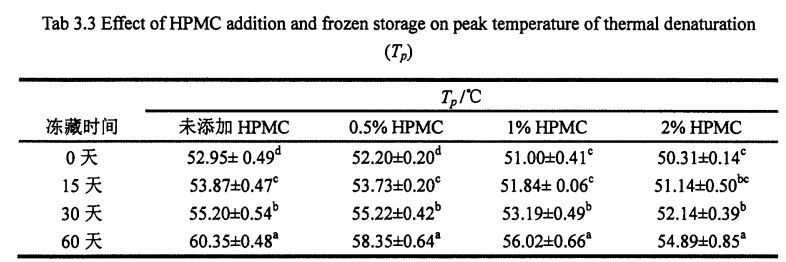
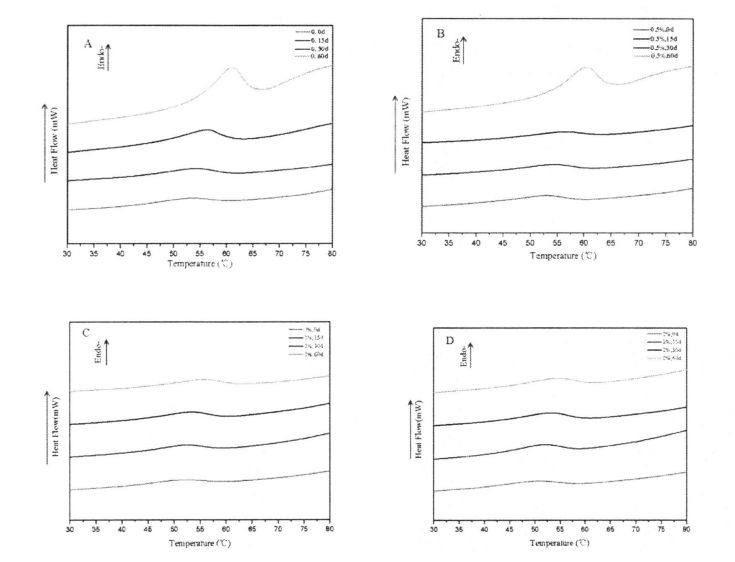
Fig 3.2 Typiske DSC -termogrammer av glutenproteiner med 0 % HPMC (A) ; med O.5 % HPMC (B) ; med 1 % HPMC (C) ; med 2 % HPMC (D) etter forskjellig tid med en frosset lagring , fra 0D til 60D indikert fra den lave kurven til den highe -lagringen , fra 0D til 60D indikert fra den lave kuren til den highe -lagringen , fra 0D til 60D til 60D -hpmc (d) etter forskjellig tid med en frosset lagring ; med 2 % HPMC (d) Note: A is the DSC curve of wheat gluten without adding HPMC; B is the addition of O. DSC curve of wheat gluten with 5% HPMC; C is the DSC curve of wheat gluten with 1% HPMC; D er DSC-kurven for hvetegluten med 2% HPMC 3.3.3 Effekter av HPMC-tilsetningsmengde og frysetid på gratis sulfhydrylinnhold (C-Sh) intermolekylær og intramolekylær kovalente bindinger er veldig viktig for stabiliteten til deig nettverksstruktur. A disulfide bond (-SS-) is a covalent linkage formed by dehydrogenation of two free sulfhydryl groups (.SH). Glutenin er sammensatt av glutenin og gliadin, førstnevnte kan danne intramolekylære og intermolekylære disulfidbindinger, mens sistnevnte bare kan danne intramolekylære disulfidbindinger [1241], er disulfidbindinger en intramolekylær/intermolekylær disulfidbinding. important way of cross-linking. Compared to adding 0%, O. The C-SH of 5% and 1% HPMC without freezing treatment and the C-SH of gluten after 60 days of freezing have different degrees of increase respectively. Specifically, the face with no HPMC added gluten C. SH increased by 3.74 "mol/g to 8.25 "mol/g, while C.sh, shellfish, with gluten supplemented with 0.5% and 1% HPMC increased by 2.76 "mol/g to 7.25""mol/g and 1.33 "mol/g to 5.66 "mol/g (Fig. 3.3). Zhao, et a1. (2012) fant at etter 120 dager med frossen lagring økte innholdet i gratis tiolgrupper betydelig [1071. Det er verdt Lokalt dannet i en kortere frysingstid [1161.
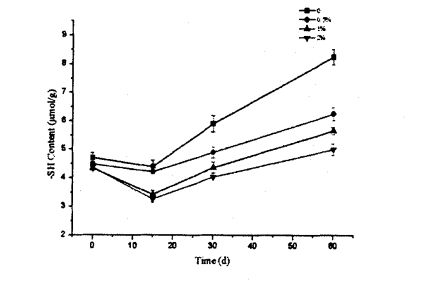
Fig 3.3 Effect of HPMC addition and frozen storage on the content of free-SH for gluten proteins As mentioned above, freezable water can form ice crystals at low temperatures and distribute in the interstices of the gluten network. Therefore, with the prolongation of freezing time, the ice crystals become larger, which squeezes the gluten protein structure more seriously, and leads to the breakage of some intermolecular and intramolecular disulfide bonds, which increases the content of free sulfhydryl groups. On the other hand, the experimental results show that HPMC can protect the disulfide bond from the extrusion damage of ice crystals, thereby inhibiting the depolymerization process of gluten protein. 3.3.4 Effekter av HPMC -tilsetningsmengde og frysing av lagringstid på tverrgående avspenningstid (T2) av våt glutenmasse Fordelingen av tverrgående avspenningstid (T2) kan gjenspeile modellen og dynamisk prosess for vannvandring i matmaterialer [6]. Figur 3.4 viser fordelingen av våt glutenmasse ved 0 og 60 dager med forskjellige HPMC-tilsetninger, inkludert 4 hovedfordelingsintervaller, nemlig 0.1.1 ms (T21), 1,10 ms (T22), 10.100 ms (død;) og 1 00-1 000 ms (T24). Bosmans et al. (2012) fant en lignende fordeling av våt glutenmasse [1261], og de antydet at protoner med avslapningstider under 10 ms kunne klassifiseres som raskt avslappende protoner, som hovedsakelig er avledet fra dårlig mobilitet. Det bundne vannet, kan karakterisere avspenningstidsfordelingen av bundet vann bundet til en liten mengde stivelse, mens Dang kan karakterisere avslapningstidsfordelingen av bundet vann bundet til en liten mengde stivelse, mens dang kan karakterisere avspenningstiden for bundet vann bundet til en liten mengde stivelse, mens Din kan karakterisere avslapningstiden for bundet vann bundet til en liten mengde stivelse. I tillegg er Kontogiorgos (2007) - T11¨, "strengene" av glutenproteinnettverksstrukturen sammensatt av flere lag (ark) med omtrent 5 nm fra hverandre, og vannet som er inneholdt i disse lagene er begrenset vann (eller bulkvann, fase vann), mobiliteten til dette vannet er mellom mobiliteten til bundet vann og fritt vann. And T23 can be attributed to the relaxation time distribution of restricted water. The T24 distribution (>100 ms) has a long relaxation time, so it characterizes free water with strong mobility. This water exists in the pores of the network structure, and there is only a weak capillary force with the gluten protein system.
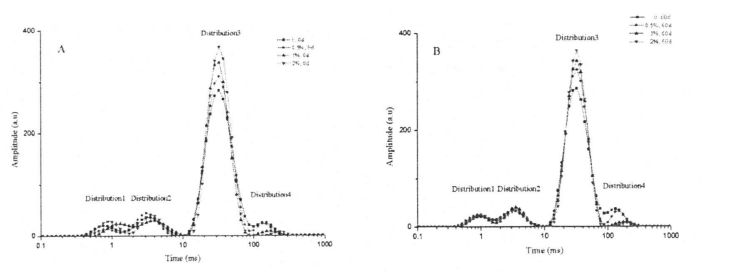
Imidlertid var det åpenbare forskjeller i høyden og området for T23 -distribusjon av våt glutenmasse som ikke var frosset og inneholdt forskjellige HPMC -tilsetninger, og med økningen av tilsetningen økte høyden og området for T23 -distribusjon (fig. 3.4). Denne endringen viser at HPMC kan øke det relative innholdet i begrenset vann betydelig, og det er positivt korrelert med den ekstra mengden innenfor et visst område. I tillegg, med utvidelsen av frysing av lagringstid, reduserte høyden og området for T23 -distribusjon av den våte glutenmassen med samme HPMC -innhold i varierende grad. Therefore, compared with bound water, limited water showed a certain effect on freezing storage. Følsomhet. This trend suggests that the interaction between the gluten protein matrix and the confined water becomes weaker. This may be because more hydrophobic groups are exposed during freezing, which is consistent with the thermal denaturation peak temperature measurements. In particular, the height and area of the T23 distribution for the wet gluten mass with 2% HPMC addition did not show a significant difference. This indicates that HPMC can limit the migration and redistribution of water, and can inhibit the transformation of the water state from the restricted state to the free state during the freezing process.
Generelt sett er den sekundære strukturen til protein delt inn i fire typer, α-spiral, β-folded, β-horners og tilfeldige krøller. The most important secondary bonds for the formation and stabilization of the spatial conformation of proteins are hydrogen bonds. Therefore, protein denaturation is a process of hydrogen bond breaking and conformational changes.

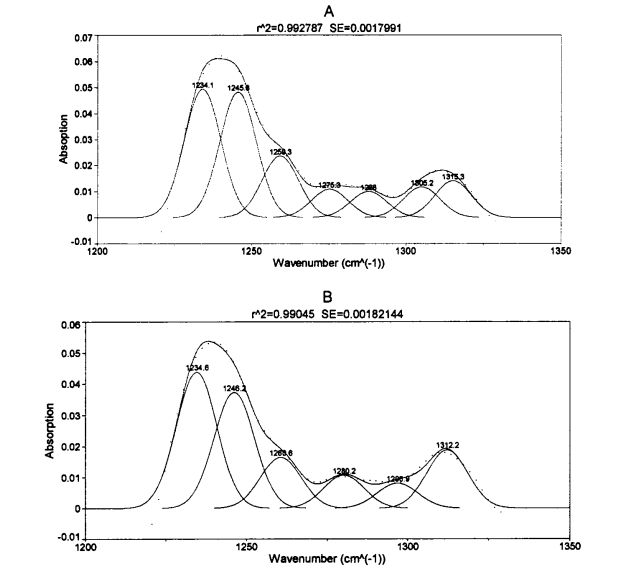
Merk: A er det infrarøde spekteret av hvetglutenprotein uten å tilsette HPMC i 0 dager med frossen lagring; B is the infrared spectrum of wheat gluten protein of frozen storage for 0 days with 2% HPMC added
endret. Some researchers believe that the increase in the relative content of the B-type structure will lead to an increase in the rigidity and hydrophobicity of the steric conformation [41], and other researchers believe that p. The increase in folded structure is due to part of the new β-Fold formation is accompanied by a weakening of the structural strength maintained by hydrogen bonding [421]. β- The increase in the folded structure indicates that the protein is polymerized through hydrophobic bonds, which is consistent with the results of the peak temperature of thermal denaturation measured by DSC and the distribution of transverse relaxation time measured by low-field nuclear magnetic resonance. Protein denaturation. On the other hand, added 0.5%, 1% and 2% HPMC gluten protein α-whirling. The relative content of helix increased by 0.95%, 4.42% and 2.03% respectively with the prolongation of freezing time, which is consistent with Wang, et a1. (2014) found similar results [134]. 0 of gluten without added HPMC. There was no significant change in the relative content of helix during the frozen storage process, but with the increase of the addition amount of freeze for 0 days. There were significant differences in the relative content of α-whirling structures.
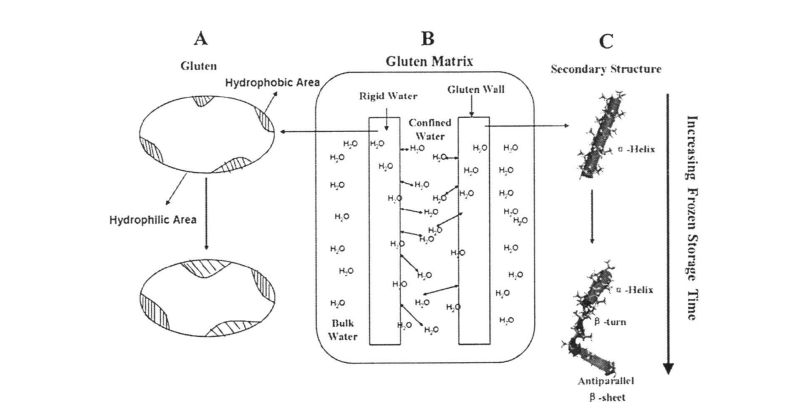
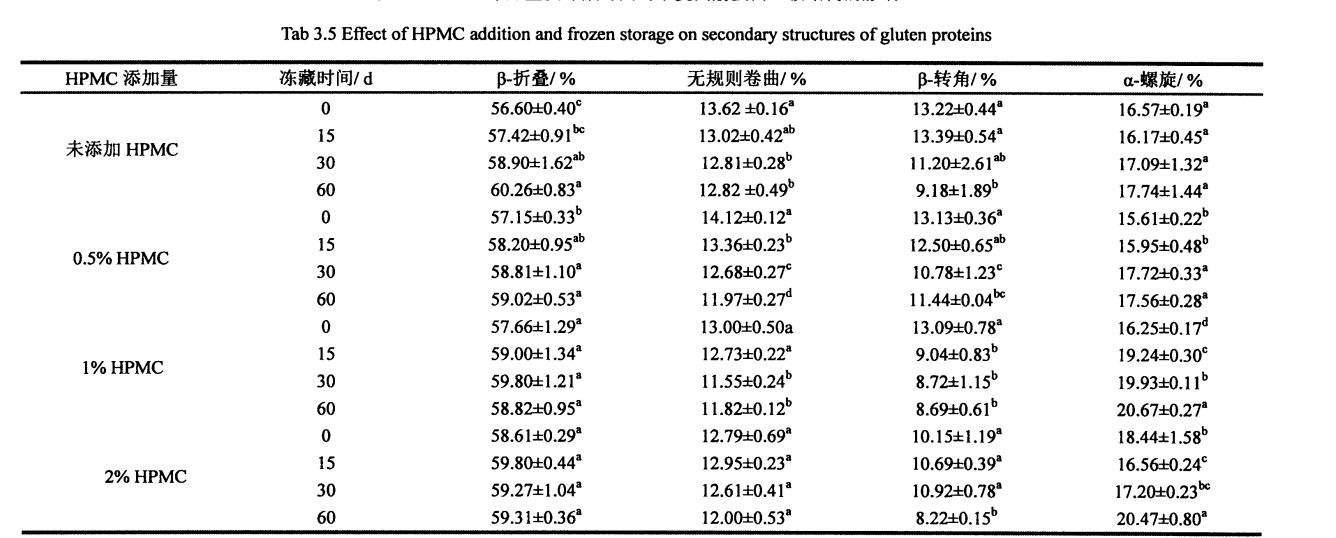
All samples with the extension of freezing time, p. The relative contents of the corners were significantly reduced. This shows that β-turn is very sensitive to freezing treatment [135. 1361], and whether HPMC is added or not has no effect. Wellner, et a1. (2005) proposed that the β-chain turn of gluten protein is related to the β-turn space domain structure of the glutenin polypeptide chain [l 37]. Except that the relative content of random coil structure of gluten protein added with 2% HPMC had no significant change in frozen storage, the other samples were significantly reduced, which may be caused by the extrusion of ice crystals. In addition, when frozen for 0 days, the relative contents of α-helix, β-sheet and β-turn structure of gluten protein added with 2% HPMC were significantly different from those of gluten protein without HPMC. This may indicate that there is an interaction between HPMC and gluten protein, forming new hydrogen bonds and then affecting the conformation of the protein; or HPMC absorbs the water in the pore cavity of the protein space structure, which deforms the protein and leads to more changes between the subunits. lukke. The increase of the relative content of β-sheet structure and the decrease of the relative content of β-turn and α-helix structure are consistent with the above speculation. During the freezing process, the diffusion and migration of water and the formation of ice crystals destroy the hydrogen bonds that maintain the conformational stability and expose the hydrophobic groups of proteins. In addition, from the perspective of energy, the smaller the energy of the protein, the more stable it is. At low temperature, the self-organization behavior (folding and unfolding) of protein molecules proceeds spontaneously and leads to conformational changes.
Protein molecules include both hydrophilic and hydrophobic groups. Generelt er proteinoverflaten sammensatt av hydrofile grupper, som kan binde vann gjennom hydrogenbinding for å danne et hydreringslag for å forhindre proteinmolekyler fra agglomering og opprettholde deres konformasjonsstabilitet. Det indre av proteinet inneholder mer hydrofobe grupper for å danne og opprettholde den sekundære og tertiære strukturen til proteinet gjennom den hydrofobe kraften. Denaturation of proteins is often accompanied by exposure of hydrophobic groups and increased surface hydrophobicity.

Merk: I samme rad er det et overskrifter uten M og B, noe som indikerer at det er en betydelig forskjell (<0,05);
After 60 days of frozen storage, add 0%, O. The surface hydrophobicity of gluten with 5%, 1% and 2% HPMC increased by 70.53%, 55.63%, 43.97% and 36.69%, respectively (Table 3.6). Spesielt har overflatens hydrofobisitet av glutenproteinet uten å tilsette HPMC etter å ha blitt frosset i 30 dager økt betydelig (P <0,05), og det er allerede større enn overflaten på glutenproteinet med 1% og 2% HPMC tilsatt etter frysing i 60 dager hydrofobisitet. Samtidig, etter 60 dager med frossen lagring, viste overflatens hydrofobisitet av glutenprotein tilsatt med forskjellige innhold signifikante forskjeller. However, after 60 days of frozen storage, the surface hydrophobicity of gluten protein added with 2% HPMC only increased from 19.749 to 26.995, which was not significantly different from the surface hydrophobicity value after 30 days of frozen storage, and was always lower than other the value of the surface hydrophobicity of the sample. This indicates that HPMC can inhibit the denaturation of gluten protein, which is consistent with the results of DSC determination of the peak temperature of heat deformation. This is because HPMC can inhibit the destruction of protein structure by recrystallization, and due to its hydrophilicity,
HPMC kan kombinere med de hydrofile gruppene på proteinoverflaten gjennom sekundære bindinger, og dermed endre overflateegenskapene til proteinet, mens du begrenser eksponeringen av hydrofobe grupper (tabell 3.6).
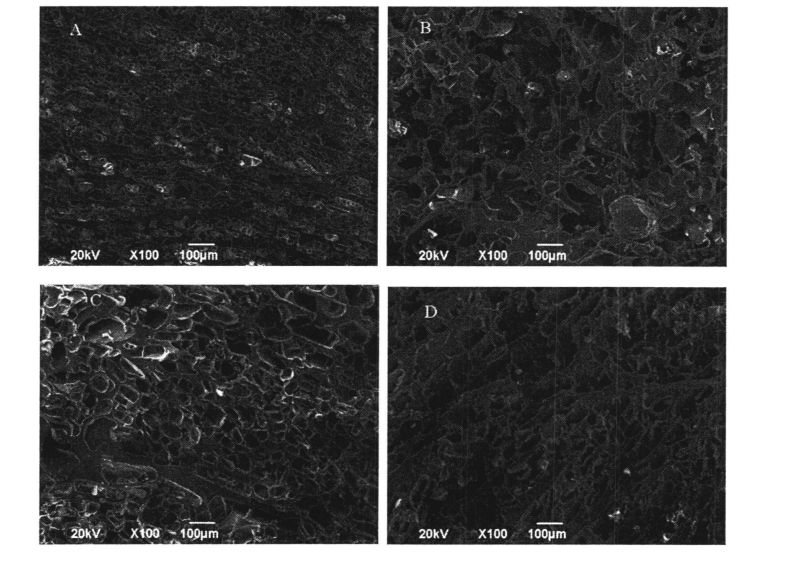
Etter 60 dager med frossen lagring ble mikrostrukturen til den våte glutenmassen uten HPMC betydelig endret (fig. 3.7, AB). At 0 days, the gluten microstructures with 2% or 0% HPMC showed complete shape, large
Small approximate porous sponge-like morphology. However, after 60 days of frozen storage, the cells in the gluten microstructure without HPMC became larger in size, irregular in shape, and unevenly distributed (Fig. 3.7, A, B), mainly due to the This is caused by the fracture of the "wall", which is consistent with the measurement results of the free thiol group content, that is, during the freezing process, the ice crystal squeezes and breaks the disulfide bond, which affects the strength and integrity of the structure. Som rapportert av Kontogiorgos & Goff (2006) og Kontogiorgos (2007), blir de interstitielle regionene i glutennettverket presset på grunn av frysekryssing, noe som resulterer i strukturell forstyrrelse [138. 1391]. In addition, due to dehydration and condensation, a relatively dense fibrous structure was produced in the spongy structure, which may be the reason for the decrease in free thiol content after 15 days of frozen storage, because more disulfide bonds were generated and frozen storage. The gluten structure was not severely damaged for a shorter time, which is consistent with Wang, et a1. (2014) observed similar phenomena [134]. At the same time, the destruction of the gluten microstructure leads to freer water migration and redistribution, which is consistent with the results of low-field time-domain nuclear magnetic resonance (TD-NMR) measurements. Noen studier [140, 105] rapporterte at etter flere fryse-tine sykluser, ble gelatiniseringen av risstivelse og deigens strukturelle styrke svakere, og vannmobiliteten ble høyere. Nonetheless, after 60 days of frozen storage, the microstructure of gluten with 2% HPMC addition changed less, with smaller cells and more regular shapes than gluten without HPMC addition (Fig. 3.7, B, D). This further indicates that HPMC can effectively inhibit the destruction of gluten structure by recrystallization.
Blant dem refererer stivelsesgelatinisering til prosessen der stivelsesgranulater gradvis blir desintegrert og hydrert i et system med høyt vanninnhold og under oppvarmingsforhold. It can be roughly divided into three main processes. 1) Reversible water absorption stage; before reaching the initial temperature of gelatinization, the starch granules in the starch suspension (Slurry) keep their unique structure unchanged, and the external shape and internal structure basically do not change. Only very little soluble starch is dispersed in the water and can be restored to its original state. 2) The irreversible water absorption stage; as the temperature increases, water enters the gap between the starch crystallite bundles, irreversibly absorbs a large amount of water, causing the starch to swell, the volume expands several times, and the hydrogen bonds between the starch molecules are broken. It becomes stretched and the crystals disappear. At the same time, the birefringence phenomenon of starch, that is, the Maltese Cross observed under a polarizing microscope, begins to disappear, and the temperature at this time is called the initial gelatinization temperature of starch. 3) Starch granule disintegration stage; starch molecules completely enter the solution system to form starch paste (Paste/Starch Gel), at this time the viscosity of the system is the largest, and the birefringence phenomenon completely disappears, and the temperature at this time is called the complete starch gelatinization temperature, the gelatinized starch is also called α-starch [141]. When the dough is cooked, the gelatinization of starch endows the food with its unique texture, flavor, taste, color, and processing characteristics.
Many studies have shown that the gel strength of starch paste decreases, it is easy to age, and its quality deteriorates under the condition of freezing storage, such as Canet, et a1. (2005) studied the effect of freezing temperature on the quality of potato starch puree; Ferrero, et a1. (1993) investigated the effects of freezing rate and different types of additives on the properties of wheat and corn starch pastes [151-156]. However, there are relatively few reports on the effect of frozen storage on the structure and properties of starch granules (native starch), which needs to be further explored. Frozen dough (excluding pre-cooked frozen dough) is in the form of ungelatinized granules under the condition of frozen storage. Therefore, studying the structure and structural changes of native starch by adding HPMC has a certain effect on improving the processing properties of frozen dough. betydning.
4.2.2 Eksperimentelle apparater
BSAL24S elektronisk balanse
Oppdagelse R3 rotasjonsreometer
Produsent
Sartorius, Tyskland
Hefei Meiling Co., Ltd.
Rigaku Manufacturing Co., Ltd.
In this experiment, a rheometer was used instead of a fast viscometer to measure the gelatinization characteristics of starch. See Bae et a1. (2014) method [1571] with slight modifications. De spesifikke programparametrene er satt som følger: Bruk en plate med en diameter på 40 mill, gapet (GAP) er 1000 mm, og rotasjonshastigheten er 5 rad/s; I) incubate at 50 °C for 1 min; ii) at 5. C/min heated to 95°C; iii) kept at 95°C for 2.5 min, iv) then cooled to 50°C at 5°C/min; v) lastly held at 50°C for 5 min.
4.2.3.3 Stivelse Pasta Gel Properties
4.2.3.4 Termodynamiske egenskaper
The thawed frozen starch samples were dried in an oven at 40 °C for 48 h, then ground and sieved through a 100-mesh sieve to obtain starch powder samples. Take a certain amount of the above samples, use D/MAX 2500V type X. The crystal form and relative crystallinity were determined by X-ray diffractometer. The experimental parameters are voltage 40 KV, current 40 mA, using Cu. Ks as X. ray source. At room temperature, the scanning angle range is 30--400, and the scanning rate is 20/min. Relativ krystallinitet (%) = Krystallisering Toppområde/totalt område x 100%, der det totale arealet er summen av bakgrunnsområdet og toppintegralområdet [1 62].

Tabell 4.2 viser påvirkningen av flere viktige indikatorer på stivelsesgelatiniseringsegenskaper, inkludert gelatiniseringstoppviskositet, minimum viskositet, endelig viskositet, forfallsverdi og takknemlighetsverdi, og gjenspeiler effekten av HPMC -tillegg og frysetid på stivelsespasta. effects of chemical properties. De eksperimentelle resultatene viser at toppviskositeten, minimum viskositet og den endelige viskositeten til stivelse uten frossen lagring økte betydelig med økningen av HPMC -tilsetningen, mens forfallsverdien og utvinningsverdien reduserte betydelig. Spesifikt økte toppviskositeten gradvis fra 727,66+90,70 cp (uten å legge til HPMC) til 758,51+48,12 cp (tilsetning av 0,5% HPMC), 809 mes) og 94,56,5 cp (tilsetning av 1% HPC) og 946,6,5 cp (tilsetning av 1% HPMC), 809,12,5 cp (tilsetning av 1% hpmc), tilsatt 2% HPMC). the minimum viscosity was increased from 391.02+18.97 CP (blank not adding) to 454.95+36.90 (adding O .5% HPMC), 485.56+54.0.5 (add 1% HPMC) and 553.03+55.57 CP (add 2% HPMC); the final viscosity is from 794.62.412.84 CP ( Without adding HPMC) increased to 882.24±22.40 CP (adding 0.5% HPMC), 846.04+12.66 CP (adding 1% HPMC) and 910.884-34.57 CP (adding 2 %HPMC); however, the attenuation value gradually decreased from 336.644-71.73 CP (without adding HPMC) to 303.564-11.22 CP (adding 0.5% HPMC), 324.19±2.54 CP (Add
Med 1% HPMC) og 393,614-45,94 cp (med 2% HPMC), falt retrogradasjonsverdien fra 403,60+6,13 cp (uten HPMC) til 427,29 og+14,50 cp (0,5% til 427,29,5,50 cp (0,5 cpmC tilsatt), 360,5,50 cp (0,5 CPMC tilsatt), 327,29,5,50 cp (0,5 cp (0,5 cpm ( 357.85+21.00 CP (2% HPMC added). This and the addition of hydrocolloids such as xanthan gum and guar gum obtained by Achayuthakan & Suphantharika (2008) and Huang (2009) can increase the gelatinization viscosity of starch while reducing the retrogradation value of starch. Dette kan hovedsakelig være fordi HPMC fungerer som en slags hydrofil kolloid, og tilsetningen av HPMC øker gelatiniseringstoppviskositeten på grunn av den hydrofile gruppen på sidekjeden, noe som gjør den mer hydrofil enn stivelsesgranulater ved romtemperatur. In addition, the temperature range of the thermal gelatinization process (thermogelation process) of HPMC is larger than that of starch (results not shown), so that the addition of HPMC can effectively suppress the drastic decrease in viscosity due to the disintegration of starch granules. Therefore, the minimum viscosity and final viscosity of starch gelatinization increased gradually with the increase of HPMC content.
På den annen side, når mengden HPMC ble tilsatt var den samme, økte den toppviskositeten, minimum viskositet, sluttviskositet, forfallsverdi og retrogradasjonsverdi av stivelsesgelatinisering betydelig med utvidelsen av frysing av lagringstid. Spesielt økte den toppviskositeten til stivelsesoppheng uten å legge til HPMC fra 727,66 ± 90,70 cp (frossen lagring i 0 dager) til 1584,44+68,11 cp (frossen lagring i 60 dager); Å legge 0,5 Toppviskositeten til stivelsesoppheng med %HPMC økte fra 758,514-48,12 cp (frysing i 0 dager) til 1415,834-45,77 cp (frysing i 60 dager); starch suspension with 1% HPMC added The peak viscosity of the starch liquid increased from 809.754-56.59 CP (freeze storage for 0 days) to 1298.19-±78.13 CP (frozen storage for 60 days); Mens stivelsesopphenget med 2% HPMC CP la til gelatiniseringstoppviskositet fra 946,64 ± 9,63 cp (0 dager frosset) økte til 1240,224-94,06 cp (60 dager frossen). Samtidig ble den laveste viskositeten til stivelsesoppheng uten HPMC økt fra 391,02-41 8,97 CP (frysing i 0 dager) til 556,77 ± 29,39 cp (frysing i 60 dager); Å legge til 0,5 minimum viskositeten til stivelsesopphenget med %HPMC økte fra 454,954-36,90 cp (frysing i 0 dager) til 581,934-72,22 cp (frysing i 60 dager); Stivelsesfjæringen med 1% HPMC tilførte minimumsviskositeten til væsken fra 485.564-54.05 CP (frysing i 0 dager) til 625.484-67.17 CP (frysing i 60 dager); Mens stivelsesopphenget la til 2% HPMC CP-gelatinisert, økte den laveste viskositeten fra 553.034-55.57 CP (0 dager frosset) til 682.58 ± 20.29 cp (60 dager frossen).

The final viscosity of starch suspension without adding HPMC increased from 794.62 ± 12.84 CP (frozen storage for 0 days) to 1413.15 ± 45.59 CP (frozen storage for 60 days). The peak viscosity of starch suspension increased from 882.24 ± 22.40 CP (frozen storage for 0 days) to 1322.86 ± 36.23 CP (frozen storage for 60 days); Toppviskositeten til stivelsesoppheng tilsatt 1% HPMC viskositeten økte fra 846,04 ± 12,66 cp (frossen lagring 0 dager) til 1291,94 ± 88,57 cp (frossen lagring i 60 dager); and the gelatinization peak viscosity of starch suspension added with 2% HPMC increased from 91 0.88 ± 34.57 CP
(Frozen storage for 0 days) increased to 1198.09 ± 41.15 CP (frozen storage for 60 days). Tilsvarende økte dempningsverdien av stivelsesoppheng uten å legge til HPMC fra 336,64 ± 71,73 cp (frossen lagring i 0 dager) til 1027,67 ± 38,72 cp (frossen lagring i 60 dager); adding 0.5 The attenuation value of starch suspension with %HPMC increased from 303.56±11.22 CP (frozen storage for 0 days) to 833.9±26.45 CP (frozen storage for 60 days); starch suspension with 1% HPMC added The attenuation value of the liquid was increased from 324.19 ± 2.54 CP (freezing for 0 days) to 672.71 ± 10.96 CP (freezing for 60 days); while adding 2% HPMC,the attenuation value of the starch suspension increased from 393.61 ± 45.94 CP (freezing for 0 days) to 557.64 ± 73.77 CP (freezing for 60 days); while the starch suspension without HPMC added The retrogradation value increased from 403.60 ± 6.13 C



(Thixotropic Loop) area, which is similar to Temsiripong, et a1. (2005) reported the same conclusion [167]. Dette kan hovedsakelig være fordi HPMC kan danne intermolekylære tverrbindinger med gelatiniserte stivelseskjeder (hovedsakelig amylosekjeder), som "bundet" separasjonen av amylose og amylopektin under virkning av skjærkraft. , for å opprettholde den relative stabiliteten og enhetligheten av strukturen (figur 4.2, kurven med skjærhastighet som abscissa og skjærspenning som ordinat).
På den annen side, for stivelse uten frossen lagring, reduserte K -verdien betydelig med tilsetning av HPMC, fra 78.240 ± 1,661 PA · SN (uten å legge HPMC) til henholdsvis 65,240 ± 1,661 Pa · Sn (uten å legge til HPMC). 683 ± 1,035 PA · Sn (tilsett 0,5% hånd MC), 43,122 ± 1,047 Pa · Sn (tilsett 1% HPMC), og 13,926 ± 0,330Pa · Sn (tilsett 2% HPMC), mens N -verdien økte signifikant, fra 0,27 ± 0,011 (uten adding -verdi til adding. 310 ± 0.009 (add 0.5% HPMC), O. 323 ± 0.013 (add 1% HPMC) and O. 43 1 ± 0.0 1 3 (adding 2% HPMC), which is similar to the experimental results of Techawipharat, Suphantharika, & BeMiller (2008) and Turabi, Sumnu, & Sahin (2008), and the increase of n value shows that the addition of HPMC makes the fluid has a tendency to change from pseudoplastic to Newtonian [168'1691]. at the same time, For the starch stored frozen for 60 days, the K, n values showed the same change rule with the increase of HPMC addition.
However, with the prolongation of freezing storage time, the values of K and n increased to different degrees, among which the value of K increased from 78.240 ± 1.661 Pa·sn (unadded, 0 days) to 95.570 ± 1, respectively. 2.421 PA · SN (ingen tillegg, 60 dager), økte fra 65,683 ± 1,035 Pa · S N (tilsetning av O. 5% HPMC, 0 dager) til 51,384 ± 1,350 Pa · S, 0 dager) til 0,5% Hpm, 60 dager), økt fra 43,12 ± 1.04 56,538 ± 1,378 PA · SN (tilsetning av 1% HPMC, 60 dager)), og økte fra 13,926 ± 0,330 Pa · SN (tilsetning av 2% HPMC, 0 dager) til 16,064 ± 0,465 PA · SN (tilsetning av 2% HPM, 60 dager); 0.277 ± 0.011 (without adding HPMC, 0 days) rose to O. 334±0.014 (no addition, 60 days), increased from 0.310±0.009 (0.5% HPMC added, 0 day) to 0.336±0.014 (0.5% HPMC added, 60 days), from 0.323 ± 0.013 (add 1% HPMC, 0 days) to 0.340 ± 0.013 (add 1% HPMC, 60 days), and from 0.431 ± 0.013 (add 1% HPMC, 60 days) 2% HPMC, 0 days) to 0.404+0.020 (add 2% HPMC, 60 days). By comparison, it can be found that with the increase of the addition amount of HPMC, the change rate of K and Knife value decreases successively, which shows that the addition of HPMC can make the starch paste stable under the action of shearing force, which is consistent with the measurement results of starch gelatinization characteristics. konsekvent.
4.3.4 Effekter av HPMC tilsetningsmengde og frossen lagringstid på dynamisk viskoelastisitet av stivelsespasta

The starch gelatinization process is accompanied by the disintegration of starch granules, the disappearance of the crystalline region, and the hydrogen bonding between starch chains and moisture, the starch gelatinized to form a heat-induced (Heat. induced) gel with a certain gel strength. As shown in Figure 4.3, for starch without frozen storage, with the increase of HPMC addition, the G' of starch decreased significantly, while G" had no significant difference, and tan 6 increased (Liquid. 1ike), which shows that during the gelatinization process, HPMC interacts with starch, and due to the water retention of HPMC, the addition of HPMC reduces the water loss of starch during the gelatinization process. Samtidig fant Chaisawang & Suphantharika (2005) at, og tilsatte Guar Gum og Xanthan Gum til Tapioca -stivelse, reduserte G 'of the stivelse pasta også [170. Amorfe områder av stivelsesgranuler skilles for å danne skadet stivelse (skadet stivelse), noe som reduserer graden av intermolekylær tverrbinding etter stivelsesgelatinisering og graden av tverrbinding etter tverrbinding. Stability and compactness, and the physical extrusion of ice crystals makes the arrangement of "micelles" (microcrystalline structures, mainly composed of amylopectin) in the starch crystallization area more compact, increasing the relative crystallinity of starch, and at the same time , resulting in insufficient combination of molecular chain and water after starch gelatinization, low extension of molecular chain (molecular chain mobility), and finally caused the gel strength of starch to decline. However, with the increase of HPMC addition, the decreasing trend of G' was suppressed, and this effect was positively correlated with the addition of HPMC. This indicated that the addition of HPMC could effectively inhibit the effect of ice crystals on the structure and properties of starch under frozen storage conditions.
The swelling ratio of starch can reflect the size of starch gelatinization and water swelling, and the stability of starch paste under centrifugal conditions. Som vist i figur 4.4, for stivelse uten frossen lagring, økte med økningen av HPMC -tilsetning conclusion of starch gelatinization characteristics. However, with the extension of frozen storage time, the swelling power of starch decreased. Sammenlignet med 0 dager med frossen lagring, reduserte hevelse av stivelse fra 8.969-A: henholdsvis 0.099 til 7.057+0 etter frossen lagring i 60 dager. .007 (no HPMC added), reduced from 9.007+0.147 to 7.269-4-0.038 (with O.5% HPMC added), reduced from 9.284+0.157 to 7.777 +0.014 (adding 1% HPMC), reduced from 9.282+0.069 to 8.064+0.004 (adding 2% HPMC). The results showed that the starch granules were damaged after freezing storage, resulting in the precipitation of part of the soluble starch and centrifugation. Therefore, the solubility of starch increased and the swelling power decreased. In addition, after freezing storage, starch gelatinized starch paste, its stability and water holding capacity decreased, and the combined action of the two reduced the swelling power of starch [1711]. On the other hand, with the increase of HPMC addition, the decline of starch swelling power gradually decreased, indicating that HPMC can reduce the amount of damaged starch formed during freezing storage and inhibit the degree of starch granule damage.
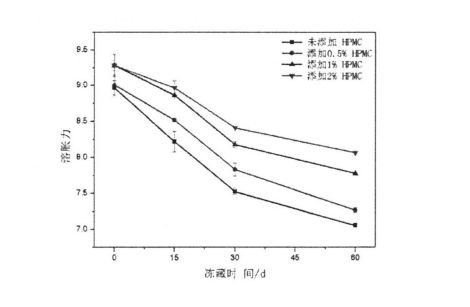
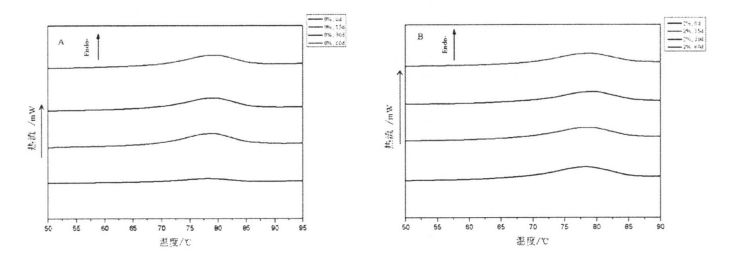
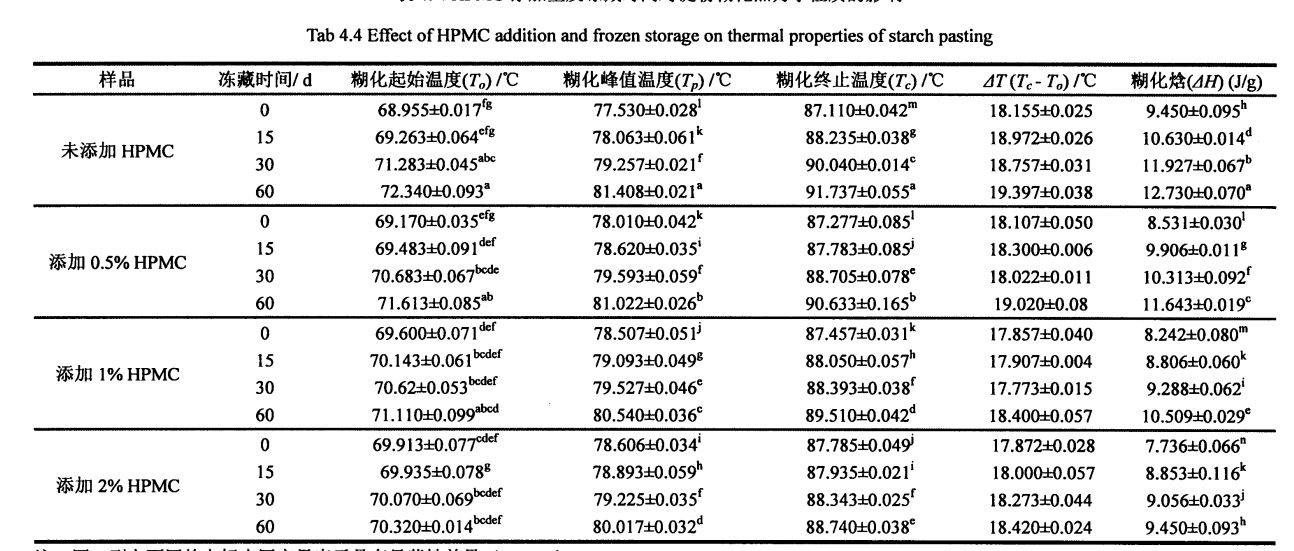
4.3.7 Effekter av I-IPMC tilsetning og frysing av lagringstid på den relative krystalliniteten til stivelse
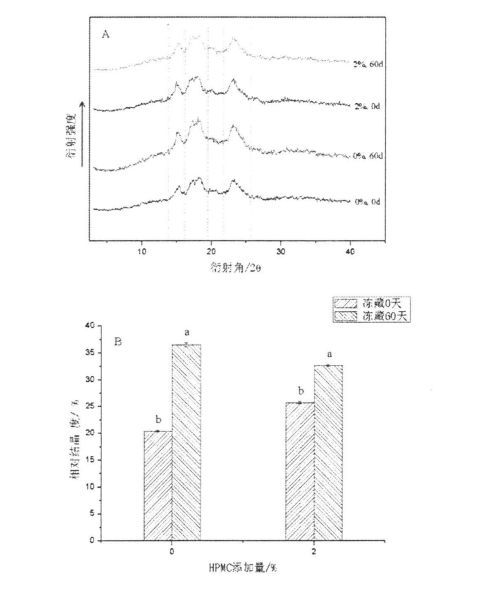
4.4 Kapitteloppsummering
Yeast is a unicellular eukaryotic microorganism, its cell structure includes cell wall, cell membrane, mitochondria, etc., and its nutritional type is a facultative anaerobic microorganism. Under anaerobe forhold produserer den alkohol og energi, mens under aerobe forhold metaboliserer den for å produsere karbondioksid, vann og energi.
In the case of frozen storage, yeast will be affected by environmental stress and affect its viability. When the freezing rate is too high, the water in the system will rapidly crystallize and increase the external osmotic pressure of the yeast, thereby causing the cells to lose water; when the freezing rate is too high. If it is too low, the ice crystals will be too large and the yeast will be squeezed and the cell wall will be damaged; both will reduce the survival rate of the yeast and its fermentation activity. I tillegg har mange studier funnet at etter at gjærcellene er bristet på grunn av frysing, vil de frigjøre en reduserende stoffredusert glutation, som igjen reduserer disulfidbindingen til en sulfhydrylgruppe, som til slutt vil ødelegge nettverksstrukturen til Gluten Protein, noe som resulterer i en nedgang i kvaliteten på pasta-produktene [176-10-10-10-10-proteinet.
Fordi HPMC har sterk vannretensjon og vannbeholderkapasitet, kan det å legge den til deigsystemet hemme dannelsen og veksten av iskrystaller. In this experiment, different amounts of HPMC were added to the dough, and after a certain period of time after frozen storage, the quantity of yeast, fermentation activity and glutathione content in unit mass of dough were determined to evaluate the protective effect of HPMC on yeast under freezing conditions.
Materialer og instrumenter
BPS. 500CL constant temperature and humidity box
Produsent
Shanghai Zhicheng Analytical Instrument Manufacturing Co., Ltd.
See Meziani, et a1. (2012)'s experimental method [17 cited, with slight modifications. Vei 5 g frossen deig i et 50 ml kolorimetrisk rør, trykk deigen til en jevn høyde på 1,5 cm i bunnen av røret, legg den deretter oppreist i en konstant temperatur og fuktighetsboks, og inkuberes i 1 time ved 30 ° C og 85% RH RH, etter å ha tatt den ut av en desim. For samples with uneven upper ends after proofing, select 3 or 4 points at equal intervals to measure their corresponding heights (for example, each 900), and the measured height values were averaged. Each sample was paralleled three times.
Weigh 1 g of dough, add it to a test tube with 9 mL of sterile normal saline according to the requirements of the aseptic operation, shake it fully, record the concentration gradient as 101, and then dilute it into a series of concentration gradients until 10'1. Tegn 1 ml fortynning fra hvert av de ovennevnte rørene, legg den til midten av 3M gjær hurtig tellestykke (med belastningsselektivitet), og plasser teststykket ovenfor i en 25 ° C -inkubator i henhold til driftskravene og kulturforholdene som er spesifisert med 3M. 5 d, take out after the end of the culture, first observe the colony morphology to determine whether it conforms to the colony characteristics of yeast, and then count and microscopically examine [179]. Each sample was repeated three times.
5.3 Resultater og diskusjon
Bevisningshøyden på deigen påvirkes ofte av den kombinerte effekten av gjærfermenteringsgassproduksjonsaktivitet og deig nettverksstruktur styrke. Blant dem vil gjærfermenteringsaktivitet direkte påvirke dens evne til å gjære og produsere gass, og mengden gjærgassproduksjon bestemmer kvaliteten på gjærede melprodukter, inkludert spesifikt volum og tekstur. Gjærens gjæringsaktivitet påvirkes hovedsakelig av eksterne faktorer (for eksempel endringer i næringsstoffer som karbon og nitrogenkilder, temperatur, pH, etc.) og interne faktorer (vekstsyklus, aktivitet av metabolske enzymsystemer, etc.).

Når det gjelder frossen lagring, siden det frosne vannet i deigsystemet omdannes til iskrystaller, økes det osmotiske trykket utenfor gjærcellene, slik at protoplastene og cellestrukturene til gjæren er under en viss grad av stress. When the temperature is lowered or kept at low temperature for a long time, a small amount of ice crystals will appear in the yeast cells, which will lead to the destruction of the cell structure of the yeast, the extravasation of the cell fluid, such as the release of the reducing substance - glutathione, or even complete death; at the same time, the yeast Under environmental stress, its own metabolic activity will be reduced, and some spores will be produced, which will reduce the fermentation gas production activity of yeast.
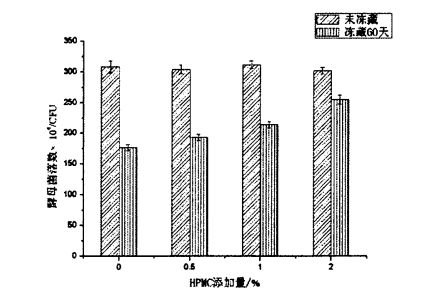
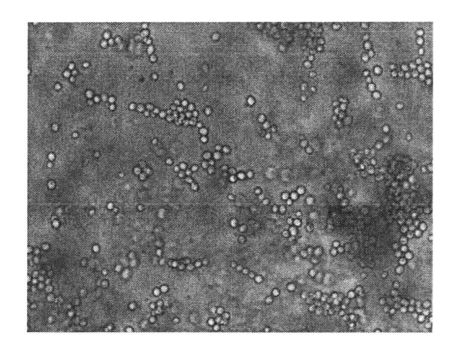
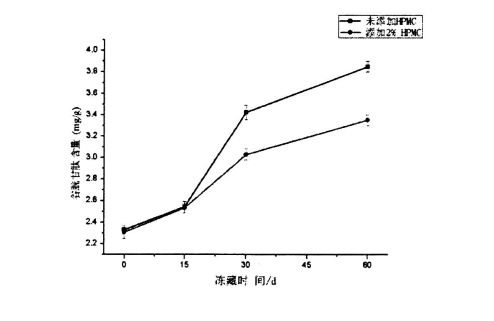
Fig 5.4 Effekt av HPMC -tilsetning og frossen lagring på innholdet i glutation (GSH)
Post Time: Oct-08-2022







